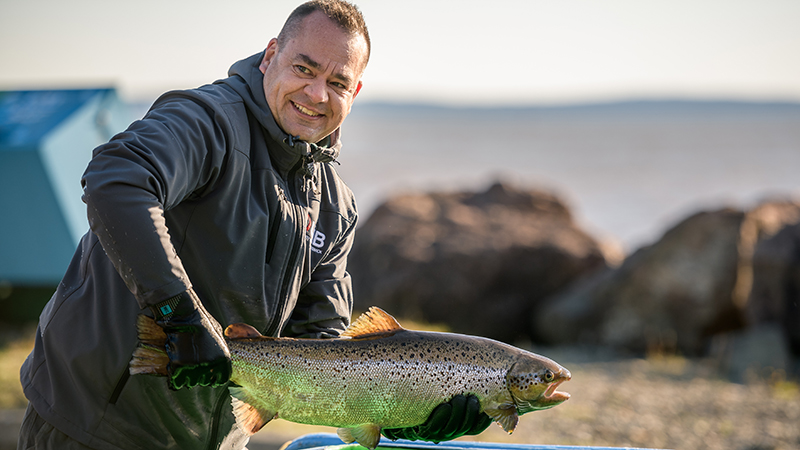N.B. salmon population winning an upstream battle, UNB research suggests
Author: UNB Newsroom
Posted on Oct 12, 2021
Category: UNB Saint John

With the highest number of returning salmon in 32 years and a record-breaking wild-hatched smolt run, the future is looking a little brighter for the endangered inner Bay of Fundy Atlantic salmon population.
Dr. Kurt Samways is the Parks Canada Research Chair in Aquatic Restoration at the University of New Brunswick. He is leading research that uses new detection technologies and is a collaborator on the Fundy Salmon Recovery project.
“This year, our system has already detected more than 100 endangered Atlantic salmon returning to Fundy National Park rivers, the highest number since 1989,” says Dr. Samways. “With higher numbers and healthier juvenile salmon in the rivers, we’re also seeing record numbers of wild smolts migrating to the ocean.”
This year, teams observed the largest wild-hatched smolt run in 20 years, a record at Fundy National Park, with estimates of more than 4,000 smolts migrating to the ocean.
Over the past five years Dr. Samways has been leading the development of one of the largest-known Passive Integrated Transponder (PIT) antenna systems for detecting migrating salmon. PIT systems use electronic tags embedded under the skin to track their movements.
These passive tags are read by antennas as they pass through them, but their ability to be accurately detected can be affected by environmental factors, including river depth, which fluctuates significantly throughout the year. To compensate for this, Dr. Samways and his team had to develop a unique design for the monitoring system.
“We’ve created a system of rectangular antennas that are suspended from a cable above the river and anchored to the riverbed on the bottom. We detect salmon as they pass through the antennas on their way upstream, sort of like a grocery store scanner,” he explains. “Being anchored as they are, our system is also strong enough to withstand flood events, which most New Brunswickers will know to be a common occurrence in our province.”
This innovative system provides researchers with substantial quantitative data, and can measure the results of other efforts to grow the salmon population. Dr. Samways says that the increase is the result of the collaborative conservation work that occurs in the Fundy Salmon Recovery project.
The project collects juvenile salmon that have spent their early lives in rivers. The young fish are then transferred to the world’s first Wild Salmon Marine Conservation Farm on Grand Manan Island. The fish grow to maturity at the farm, which is operated by project partner Cooke Aquaculture.
“When mature, these fish are returned to their native rivers to spawn naturally,” says Dr. Samways. “Some of these released salmon even survive in the wild to return again to spawn in following years. These are the salmon that we are detecting.”
With the data collected, Dr. Samways’ research has identified benefits beyond a simple increase of the salmon population. “With increasing numbers of adult salmon in the rivers, primary productivity of the freshwater ecosystem is also increasing,” he says. “This is because adult salmon deliver marine-derived nutrients to the river, which in turn increases the food available for juvenile salmon. Our graduate students have further demonstrated that there are more and larger juvenile salmon now, versus when adult salmon numbers were very low.”
In addition to UNB and Cooke Aquaculture, the project also includes partners Parks Canada, Fort Folly First Nation and the Atlantic Canada Fish Farmers Association.
“This project demonstrates the positive impact that we can have on our world when we bring together academia, government and industry and work in collaboration with Indigenous communities,” says Dr. David MaGee, UNB’s vice-president (research). “By working together, we can address the grand challenges we face, all while discovering new information and creating innovative solutions.”
Media contact: Jeremy Elder-Jubelin
Photo credit: Nigel Fearon
